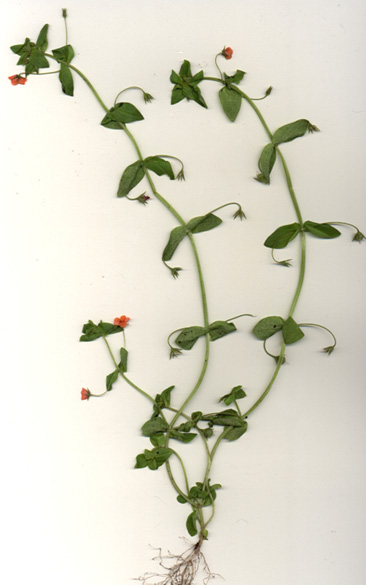
|
| Scarlet Pimpernel; Anagallis arvensis L. |
Primrose Family; PRIMULACEÆ
|
| A lovable weed is the Scarlet Pimpernel. Petite, attractive in bloom and not obnoxiously rampant, it actually fits in the
wildflower category with the same suave ease as Foxglove, Forget-Me-Not and similar gorgeous, but
too-fecund, plants. Few members of the Primrose Family are weedy, and Scarlet Pimpernel is the most so. Non-weedy (or at any rate less-weedy) kin include Cyclamen, Lysimachia
and Primula, plus the native woodland Starflower (Trientalis latifolia). In the Seattle area, Scarlet Pimpernel is not
often seen, but is common enough to those of us who grub in the dirt and take the time to observe small things. Since it is highly distinctive we should know it by name. |
| Red Chickweed is a superb way to describe it. Like the ubiquitous Chickweed, it has square stems, bears its leaves in opposite
pairs (rarely trios), and is lissome, almost floppy, sprawling about, easily uprooted. Unlike Chickweed, its flowers are a showy orange-red,
not an inconspicuous white, and its flavor is disgustingly acrid, not gently bland. The common name Poison Chickweed comes from the
burning, bitter taste. I am sure that the men who wrote in books that it has been eaten in salads, have never tasted it themselves. A salad so foul
the very Devil could use it as a torture! The same acridity, bordering on poisonousness, is found in some related plants. Don't eat
Scarlet Pimpernel. |
A summer annual, it grows in full sun or in considerable shade. The leaves are never more than three-fourths of an inch long. The
scarlet of its flowers is scarcely equaled in weeds. Only Orange Hawkweed comes close. The flowers begin opening in late May, and are
borne singly on threadlike stalks. Finicky, they remain shut during cloudy weather, rain, eclipses, at night --opening only in the sunny
mid-part of the day. Thus it has been called the Shepherd's or Poor Man's Barometer or Weatherglass. John Gerard explained these names
nearly 400 years ago:
|
"They floure in Summer, and especially in the Moneth of August, at what time the husbandmen having occasion to go unto
their harvest worke, will first behold the floures of Pimpernell, thereby they know the weather that shall follow the next day after;
as for example, if the floures be shut close up, it betokeneth raine and foule weather; contrariwise, if they be spread abroad,
faire weather."
|
From the Old World, it now grows practically everywhere. In the past it had medicinal uses, such as to treat rabies. Some people
so love its flowers that they grow it intentionally. Blue, rose and white-flowered variants exist, but I have seen none wild. In the
Language of Flowers, this delightful little pest mischievously signifies either "Assignation" or "Change."
|
Originally published as the Seattle Tilth newsletter Weed of the Month in July 1991, along with an illustration drawn by Annie Figliola.
Back |
|
|

